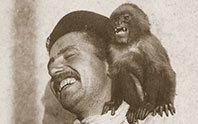 Not all member efforts were dedicated to building and sailing. According to theSausalito News (December 26, 1890) “Among the many attraction at CYC is a young gorilla … by the name of Johnson, and although only a year old drinks whiskey straight.” The newspaper also reported later that “Dick,” CYC’s pet raccoon, passed away the following May. Members had also befriended a black bear that roamed the beach, and had a ring-tailed monkey. Club legend has a story about what happened to the bear, but there are no reports about what became of the gorilla.
Not all member efforts were dedicated to building and sailing. According to theSausalito News (December 26, 1890) “Among the many attraction at CYC is a young gorilla … by the name of Johnson, and although only a year old drinks whiskey straight.” The newspaper also reported later that “Dick,” CYC’s pet raccoon, passed away the following May. Members had also befriended a black bear that roamed the beach, and had a ring-tailed monkey. Club legend has a story about what happened to the bear, but there are no reports about what became of the gorilla.
First Club Dinner 1890
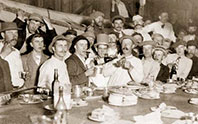 What became the first of the Annual Member Dinner was held in 1890, in San Francisco, as the logistics of holding it at the small clubhouse in Tiburon had not been resolved. By the following year the membership had increased to 175 and as reported in the Overland Monthly: “Without a doubt, the most active and progressive of the local yacht clubs is the youngest, Corinthian….”
What became the first of the Annual Member Dinner was held in 1890, in San Francisco, as the logistics of holding it at the small clubhouse in Tiburon had not been resolved. By the following year the membership had increased to 175 and as reported in the Overland Monthly: “Without a doubt, the most active and progressive of the local yacht clubs is the youngest, Corinthian….”
The first New Year’s Day Dinner was in 1892, and was a relatively informal affair. Then “Boss” John Keefe (Port Captain for 24 years!) combined it with the Annual Dinner on January 1, 1897.
Cooks & Waiters Union 1898
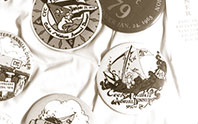 Moreover, the members cooked the dinner themselves, starting a tradition that give rise in 1898 to forming a tongue-in-cheek “union.” First called “Medera Parlour,” changed in 1900 to “Freda Court 7-11” it was eventually named Marine Local 23.
Moreover, the members cooked the dinner themselves, starting a tradition that give rise in 1898 to forming a tongue-in-cheek “union.” First called “Medera Parlour,” changed in 1900 to “Freda Court 7-11” it was eventually named Marine Local 23.
Club legend is that dinner the first year included the black bear, which was kept in one of the Pneumonia Alley lockers (in those days, sleeping rooms). It had grown big and unmanageable, and so was dispatched, cooked and eaten. History records, however, menu on this day in fact was roast beef – cooked in Tiburon and paraded over to the clubhouse.
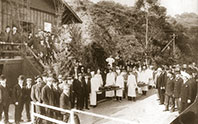 More than a century later the tradition remains alive and well, although no longer held on New Year’s Day, and the roast beef only gets paraded from the galley to the ballroom. Once a year the staff are sent home for the weekend, the decks cleared of women and visitors, and some 40 to 50 members, decked out in white uniforms and chef hats, prepare and serve a banquet, complete with entertainment and music. This is accompanied by a strike, first organized at the inaugural dinner to lend authenticity to the Union, which is rapidly broken up by liberal rounds of booze. A highlight of the dinner in the early days was a concoction named Corinthianscwasersportsgelschaltzweibelsalad (described as a “liver-capiszer”).
More than a century later the tradition remains alive and well, although no longer held on New Year’s Day, and the roast beef only gets paraded from the galley to the ballroom. Once a year the staff are sent home for the weekend, the decks cleared of women and visitors, and some 40 to 50 members, decked out in white uniforms and chef hats, prepare and serve a banquet, complete with entertainment and music. This is accompanied by a strike, first organized at the inaugural dinner to lend authenticity to the Union, which is rapidly broken up by liberal rounds of booze. A highlight of the dinner in the early days was a concoction named Corinthianscwasersportsgelschaltzweibelsalad (described as a “liver-capiszer”).
Remodel and Rebuild
According to the Sausalito News, “On February 15, 1900 a “Night with the Corinthians” was held at the Native Sons Hall in San Francisco with proceed to benefit enlarging the clubhouse.” Membership was now 220.
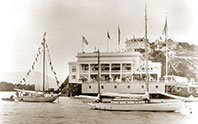 In August 1908 the club had finally purchased its property from the Corinthian Island Company (successor to T.B. Valentine) for the sum of $4,000. Three years later the originial clubhouse was partially razed to make way for a much larger building. Retaining only the “Yachtsmen’s Accommodations” (Pneumonia Alley), the magnificent new clubhouse, standing today, was built in six months at a cost of $25,000, including $10,000 of debt. It was unveiled on July 4, 1912.
In August 1908 the club had finally purchased its property from the Corinthian Island Company (successor to T.B. Valentine) for the sum of $4,000. Three years later the originial clubhouse was partially razed to make way for a much larger building. Retaining only the “Yachtsmen’s Accommodations” (Pneumonia Alley), the magnificent new clubhouse, standing today, was built in six months at a cost of $25,000, including $10,000 of debt. It was unveiled on July 4, 1912.
In the meantime CYC was making its presence felt in Bay Area yacht racing. In 1897 Corinthian had won the inaugural Perpetual Challenge Cup, and competition between CYC and SFYC (with an occasional interloper) was becoming serious. In 1904 the extreme racing yacht “Corinthian” was built by W.F. Stone solely to defend the Perpetual Challenge Cup against SFYC, which she successfully did, winning again in 1905. The boat was then withdrawn from competition forever. Her name board survives and is displayed in the club entrance lobby. The Perpetual Challenge Cup was won by Corinthian 27 times in the next 44 events.